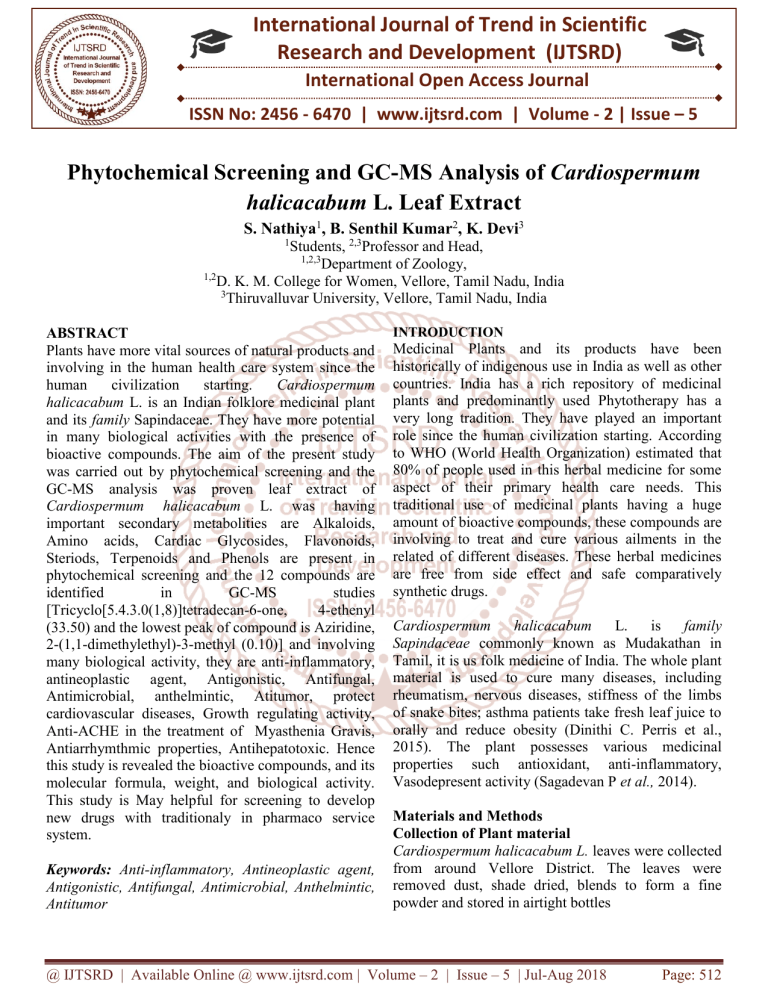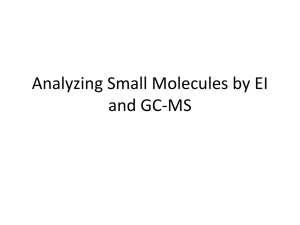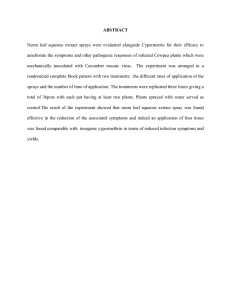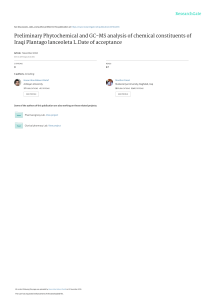
International Journal of Trend in Scientific
Research and Development (IJTSRD)
International Open Access Journal
ISSN No: 2456 - 6470 | www.ijtsrd.com | Volume - 2 | Issue – 5
Phytochemical Screening and GC-MS Analysis of Cardiospermum
halicacabum L. Leaf Extract
S. Nathiya1, B. Senthil Kumar2, K. Devi3
1
Students, 2,3Professor and Head,
1,2,3
Department of Zoology,
1,2
D. K. M. College for Women, Vellore, Tamil Nadu, India
3
Thiruvalluvar University, Vellore, Tamil Nadu, India
ABSTRACT
Plants have more vital sources of natural products and
involving in the human health care system since the
human
civilization
starting.
Cardiospermum
halicacabum L. is an Indian folklore medicinal plant
and its family Sapindaceae. They have more potential
in many biological activities with the presence of
bioactive compounds. The aim of the present study
was carried out by phytochemical screening and the
GC-MS analysis was proven leaf extract of
Cardiospermum halicacabum L. was having
important secondary metabolities are Alkaloids,
Amino acids, Cardiac Glycosides, Flavonoids,
Steriods, Terpenoids and Phenols are present in
phytochemical screening and the 12 compounds are
identified
in
GC-MS
studies
[Tricyclo[5.4.3.0(1,8)]tetradecan-6-one,
4-ethenyl
(33.50) and the lowest peak of compound is Aziridine,
2-(1,1-dimethylethyl)-3-methyl (0.10)] and involving
many biological activity, they are anti-inflammatory,
antineoplastic agent, Antigonistic, Antifungal,
Antimicrobial, anthelmintic, Atitumor, protect
cardiovascular diseases, Growth regulating activity,
Anti-ACHE in the treatment of Myasthenia Gravis,
Antiarrhymthmic properties, Antihepatotoxic. Hence
this study is revealed the bioactive compounds, and its
molecular formula, weight, and biological activity.
This study is May helpful for screening to develop
new drugs with traditionaly in pharmaco service
system.
Keywords: Anti-inflammatory, Antineoplastic agent,
Antigonistic, Antifungal, Antimicrobial, Anthelmintic,
Antitumor
INTRODUCTION
Medicinal Plants and its products have been
historically of indigenous use in India as well as other
countries. India has a rich repository of medicinal
plants and predominantly used Phytotherapy has a
very long tradition. They have played an important
role since the human civilization starting. According
to WHO (World Health Organization) estimated that
80% of people used in this herbal medicine for some
aspect of their primary health care needs. This
traditional use of medicinal plants having a huge
amount of bioactive compounds, these compounds are
involving to treat and cure various ailments in the
related of different diseases. These herbal medicines
are free from side effect and safe comparatively
synthetic drugs.
Cardiospermum
halicacabum
L.
is
family
Sapindaceae commonly known as Mudakathan in
Tamil, it is us folk medicine of India. The whole plant
material is used to cure many diseases, including
rheumatism, nervous diseases, stiffness of the limbs
of snake bites; asthma patients take fresh leaf juice to
orally and reduce obesity (Dinithi C. Perris et al.,
2015). The plant possesses various medicinal
properties such antioxidant, anti-inflammatory,
Vasodepresent activity (Sagadevan P et al., 2014).
Materials and Methods
Collection of Plant material
Cardiospermum halicacabum L. leaves were collected
from around Vellore District. The leaves were
removed dust, shade dried, blends to form a fine
powder and stored in airtight bottles
@ IJTSRD | Available Online @ www.ijtsrd.com | Volume – 2 | Issue – 5 | Jul-Aug 2018
Page: 512
International Journal of Trend in Scientific Research and Development (IJTSRD) ISSN: 2456-6470
Extract preparation
25g of plant material was soxholated with double
distilled water at 1000 C for 12 × 3hrs. The soxholated
material was filtered and the filtrate was evaporated
using as oven at 50 – 60 0C. Appropriate weights of
the residue were prepared in distilled water to acquire
the various concentrations used for this analysis
(Lohiya et al., 1994).
Phytochemical analysis
The extract of Cardiospermum halicacabum L.tested
for the bioactive compounds by using the following
methods.
Test for Saponins
5 ml of sample was shaken vigorously with 5 ml of
distilled water in a test tube and warmed. The
formation of stable foam was taken as an indication of
the presence of saponins.
Test for Phlorotannins
About 2 ml of sample was added to 2 ml of 1% HCl
and the mixture was boiled. Deposition of a red
precipitate was taken as an evidence for the presence
of phlorotannins.
Test for Glycoside; Liebermanns test:
2 ml of the sample was dissolved in 2 ml of
chloroform and then 2 ml of acetic acid was added in
it. The solution was cooled well in ice. Sulphuric acid
was then added carefully. A color change from violet
to blue to green indicates the presence of a steroid
nucleus (that is, a glycone portion of glycoside).
Test for Alkaloids
3 ml sample was stirred with 3 ml of 1% HCl on the
steam bath. Mayer and Wagner’s reagent were then
added to the mixture. Turbidity of the resulting
precipitate was taken as an evidence for the presence
of alkaloid
added. Formation of green precipitate was an
indication of presence of tannins.
Test for Terpenoids
2ml of the sample was dissolved in 2ml of chloroform
and evaporated to dryness. 2ml of concentrated
sulphuric acid was then added and heated for about
2min. Development of a grayish colour indicates the
presence of terpenoids
Tests for steroids
A red colour produced in the lower chloroform layer
when 2ml of sample was dissolved in 2ml of
chloroform and 2ml concentrated sulphuric acid is
added in it indicates the presence of steroids.
GC-MS Analysis
The GC-MS analysis of leaf extract Cardiospermum
halicacabum was performed using a Shimdzu GC2010 Plus gas chromatograph was equipped with a
straight deactivated 2 mm direct injector liner and a
15m Alltech EC-5 column (250μ I.D., 0.25μ film
thickness). A split injection was used for sample
introduction and the split ratio was set of 10:1. The
oven temperature program was programmed to start at
35°C, hold for 2minutes, then ramp at 20°C per
minute to 450°C and hold for 5 minutes. The helium
carrier gas was set to 2 ml/minute flow rate (constant
flow mode). A Direct connection with capillary
column metal quadupole mass filter pre-rod mass
spectrometer operating in electron ionization (EI)
mode with software GC-MS solution ver. 2.6 was
used for all analyses. Low-resolution mass spectra
were acquired at a resolving power of 1000 (20%
height definition) and scanning from m/z 25 to m/z
1000 at 0.3 seconds per scan with a 0.2 Second interscan delay. High resolution mass spectra were
acquired at a resolving power of 5000 (20% height
definition) and scanning the magnet from m/z 65 to
m/z 1000 at 1 second per scan.
Test for Flavanoids
To 1 ml of aqueous extract, 1 ml of 10% lead acetate
solution was added. The formation of a yellow
precipitate was taken as a positive test for flavonoid.
From the analysis of the plant the major
phytochemical constituents which showed the positive
result are being glycosides, alkaloids, and flavonoids.
Identification of the components of the compound
was matching their recorded spectra with the data
bank mass spectra of NIST library V 11 provided by
the instrument software and GC-MS metabolomics.
Test for Tannins
About 2ml of the sample was stirred with 2ml of
distilled water and few drops l FeCl3 solution was
RESULT
The Phytochemical screening of Cardiospermum
halicacabum L. leaf was analyzed by standard
The Database was used for the similarity search in
retention index.
@ IJTSRD | Available Online @ www.ijtsrd.com | Volume – 2 | Issue – 5 | Jul-Aug 2018
Page: 513
International Journal of Trend in Scientific Research and Development (IJTSRD) ISSN: 2456-6470
methods and identified the bioactive compounds they
are flavonoids, glycosides, tannins, terpenoids,
phenol,
steroids,
alkaloids,
saponins
and
carbohydrates are found in the leaf extract
cardiospermum halicacabum L. and the finding
compounds are present in the Table 1.
Table1. Phytochemical Constituents analysis of Cardiospermum halicacabum L.
S.
No
1.
2.
3.
4.
5.
6.
7.
8.
9.
10.
11.
12.
13.
Name of the Test
Alkaloids
Amino acids
Anthraquinones
Carbohydrates
Cardiac Glycosides
Coumorins
Flavonoids
Proteins
Saponins
Steriods
Tannins
Terpenoids
Phenols
Phytochemical analysis of
Cardiospermum halicacabum L.
+
+
-
The Bioactive compounds present in the leaf extract
of Cardiospermum halicacabum L. were identified by
using GC-MS analysis shows active principles with
their retention time (RT), Molecular formula,
Molecular Weight (MW) and concentration (peak area
%) are presented in Table 2. The 15 prevailing
+
+
+
+
+
compounds are identified the highest of the peaks of
compound is Tricyclo[5.4.3.0(1,8)]tetradecan-6-one,
4-ethenyl (33.50) and the lowest peak of compound is
Aziridine, 2-(1,1-dimethylethyl)-3-methyl (0.10).
These bioactive components are present in the leaf
extract of Cardiospermum halicacabum L.
Table2. Phytocomponents identified in the leaf extract of Cardiospermum halicacabum L. by GC-MS
analysis.
S.
No.
1.
2.
3.
4.
5.
6.
7.
8.
9.
10.
11.
12.
RT
5.48
6.45
7.33
19.91
25.92
29.10
35.73
37.66
40.55
45.13
C
45.50
45.95
Peak
Value
0.10
0.01
0.03
0.12
0.01
0.01
0.02
0.01
0.01
15.21
31.78
33.50
Compound Name
Aziridine, 2-(1,1-dimethylethyl)-3-methyl
DBenzoic acid, 2-(1-oxopropyl)-, methyl ester
3-(1,4-Dioxa-8-aza-spiro[4.5]dec-8-ylmethyl)
Pyridostigmine Bromide $$
Bicyclo(3.3.1)nonan-9-one, 2-(1-pyrrolidinyl)
7-methoxy-5, 11, 12-trihydroxy coumestan
3-Hydroxy-7,8-dihydro-.beta.-ionol
3,3-Dimethyl-1-(2-carboxyphenyl)triazene
Luteolin 2-hydroxy methane
Di-n-decylsulfone
Apigenin Sulfate
Tricyclo[5.4.3.0(1,8)]tetradecan-6-one, 4 ethenyl
Molecular
Molecular
Weight
Formula
141
C9H19N
192
C11H12O3
336
C14H18BrMgNO2
261
C9H13BrN2O2
2017
C13H21NO
314
C16H10O7
208
C13H20O2
193
C9H11N3O2
286
C15H10O6
346
C20H42O2S
364
C15H8O9S
378
C22H34O5
@ IJTSRD | Available Online @ www.ijtsrd.com | Volume – 2 | Issue – 5 | Jul-Aug 2018
Page: 514
International Journal of Trend in Scientific Research and Development (IJTSRD) ISSN: 2456-6470
The highest Peak value of compound Apigenin
Sulfate 45.50 Atitumor and protect cardiovascular
diseases, Di-n-decylsulfone 15.21 Antigonistic,
Antifungal, Antimicrobial, Antihelmintic Luteolin 2hydroxy
methane
0.01
Antioxidant,
antiinflammatory, antineoplastic agent.
Table.3 Represent the Biological activity of Identified
in the leaf extract of Cardiospermum halicacabum L.
S.
Biological
Compound Name
No.
activity
3,3-Dimethyl-1-(2Anti Neo plastic
1.
carboxyphenyl)triazene
agent
Antioxidant, antiLuteolin 2-hydroxy
inflammatory,
2.
methane
antineoplastic
agent
Antigonistic,
Antifungal,
3.
Di-n-decylsulfone
Antimicrobial,
Antihelmintic
Antitumor, protect
4.
Apigenin SulfateS
cardiovascular
diseases,
3-(1,4-Dioxa-8-azaGrowth regulating
5.
spiro[4.5]dec-8-ylmethyl)
activity
Anti-ACHE in the
Pyridostigmine Bromide
treatment of
6.
$$
Myasthenia
gravis.
Bicyclo(3.3.1)nonan-9Antiarrhymthmic
7.
one, 2-(1-pyrrolidinyl)
properties
7-methoxy-5, 11, 128.
Antihepatotoxic
trihydroxy coumestan
DISCUSSION
In the present study revealed the secondary
metabolites of alkaloids, Amino acids, Cardiac
Glycosides, Flavonoids, Steriods, Terpenoids and
Phenols are present in the leaf extract of
Cardiospermum halicacabum L. These effective
compounds are medically important and more
potential to responsible for food industry and
pharmacological activities. The GC-MS analysis is a
precious tool for identification of phytocompounds. In
the present study identified to 12 bio active
compounds in the leaf extract of Cardiospermum
halicacabum L. and these bio active compounds are
responsible in the many biological, anti-inflammatory,
antineoplastic agent, Antigonistic, Antifungal,
Antimicrobial, anthelmintic, Atitumor, protect
cardiovascular diseases, Growth regulating activity,
Anti-ACHE in the treatment of Myasthenia Gravis,
Antiarrhymthmic properties, Antihepatotoxic. In this
study of phytochemical screening and GC-MS
analysis properties, they are antitumor activity,
Antioxidant is proving this plant have more bioactive
compounds and posses medicinal property.
CONCLUSION
The phytochemical screening and GC-MS analysis of
leaf extract of Cardiospermium halicacabum L.
constitute various bioactive compounds. These
components have many therapeutic properties also
involved in many biological activity and various
ailments are cure traditionally in medicinal field.
Hence this investigation give the information of leaf
extract of Cardiospermium halicacabum L. is
pharmacology more potential for using the method of
phytochemical screening and GC-Ms analysis are
proven.
ACKNOWLEDGEMENT
We would like to thank My Guide and Supervisor Dr.
K. Devi Associate professor PG and Research
Department of Zoology, D. K. M. College for Women
Vellore – 1 for guiding and supporting me.
]REFERENCE
1. Aneesh TP. Mohamed Hisham, Sonal Sekhar M,
Manjusree Madhu Deepa TV. International
Market Scenario of Traditional Indian Herbal
Drugs. Int. J. Green Pharm. 2009; 3 suppl 3: 184190.
2. Home page on the internet, World Health
Organization,
available
from
url
http://www.Who.int/medicines/areas/traditional/de
finitions/en.
3. Sagadevan P, S. N. Suresh, S. Rathish kumar and
Revathy Rajan A. R., Studies on phytochemical
composition, antibacterial and antioxidant
potential of methanolic stem extract of
@ IJTSRD | Available Online @ www.ijtsrd.com | Volume – 2 | Issue – 5 | Jul-Aug 2018
Page: 515
International Journal of Trend in Scientific Research and Development (IJTSRD) ISSN: 2456-6470
Cardiospermum halicacabum L. (Sapindaceae).,
International Journal of Biosciences and
Nanosciences Volume 1 (1), 2014, PP. 12-18.
4. L. Dinithi C. Perris, M. A. T. Dhanuska and T. A.
H. D. G. Jayathilake, 2015 Evaluation of Aqueous
of Leaf Extract of Cardiospermum halicacabum
(L.) on Fertility of Male Rats, BioMed Research
International.
5. Deshmukh, O. S., 2015 GC-MS Analysis of Root
Acetone Extracts of Spatholobus Purpureus – A
High Ethno – Veterinary Medicinal Value plant,
International Journal of Current Research, Vol. 7,
Issue, 11, PP.23039-23042, November.
6. Xiang Zhou, Feng Wang, Ruijun Zhou, Xiuming
Song, Meilien Xie, Apigenin: 2017. A current
review on its beneficial biological activities,
WILEY Journal of Food Biochemistry, DOI:
10.1111/jfbc.12376.
7. A. Sh. Sharifkanov, S. K. Alimzhanova, Zh. A.
Abilov, and A. A. Bektibaeva, 2001 Synthesis,
Structure and Growth Regulating activity of 1-(6,9
– Dimethyl-1, 4-dioxa-8-azaspiro[4,5]dec-8ylmethyl)-1H-pyridin-2-one., Russian journal of
Applied chemistry, Vol.74, No. 2, 2001, PP. 277279. Translated from Zhurnal Prikladoni Khimi,
Vol. 74, No. 2, 2001. PP. 272-274.
9.
Karuppasamy Balamurugan, Antony Nishanthini,
Veerababu Ramasamy Mohan. 2012 GC-MS
analysis of polycarpaea corymbosa (L.) Lam
whole plant, Asian Pasific Journal of Tropical
Biomedicine
10. Muthulakshmi A, Joshibhi Margret R, Mohan V
R. GC-MS analysis of bioactive components of
Feronia elephantum correa (Rutacceae) App.
Pharmac. Sci. 2012 2:69-74.
11. A. Malar Retna and P. Ethalsha, Phytochemical
Tests, Antioxidant Potential and TLC Analysis of
Ipomoea Pes Caprae and Catharanthus Roseus,
International Journal of Natural Products
Research, 2014; 4(2): 58-64.
12. Tiana Fitrilia, Maria Bintang, Mega Safithri,
Phytochemical Screening and antioxidant activity
of clove mistletoe leaf extracts (Dendrophthoe
Pentandra (L. )Miq)., IOSR Journal of Pharmacy
Volume 5. Issure 8 August 2015, PP. 13-18.
13. R. Hemalatha P. Nivetha, C. Mohanapriya, G.
Sharmila, C. Muthukumaran, M. Gopinath,
Phytochemical Composition, GC-MS analysis, in
vitro antioxidant and antibacterial potential of
clove flower bud (Eugenia caryophyllus)
methanolic extract, J Food Sci Technol Feb 2016.,
53(2): 1189-1198.
8. Robert E. Smith, Medicinal Chemistry- Fusion of
Traditional and Western Medicine.
@ IJTSRD | Available Online @ www.ijtsrd.com | Volume – 2 | Issue – 5 | Jul-Aug 2018
Page: 516



